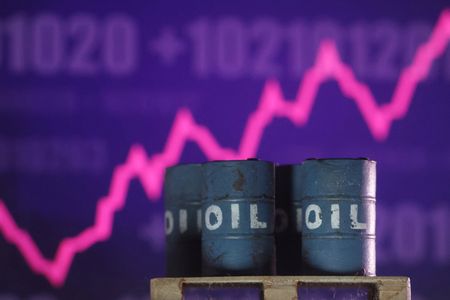By Arathy Somasekhar
HOUSTON (Reuters) – Oil prices settled higher on Wednesday by more than $1 a barrel as investors worried about possible supply disruptions after Poland downed drones in its airspace and the U.S. pushed for new sanctions on buyers of Russian oil the day after an Israeli attack in Qatar, but a report showing swelling U.S. supplies capped gains.
Brent crude futures settled up $1.10, or 1.7%, at $67.49 a barrel. U.S. West Texas Intermediate crude futures rose $1.04, or 1.7%, to settle at $63.67 a barrel.
Geopolitical tensions mounted when Poland shot down drones over its airspace during a widespread Russian attack in western Ukraine, the first shots by a NATO member in the Russia-Ukraine war. On Tuesday, prices had settled 0.6% higher after Israel said it had attacked leadership of the Palestinian militant group Hamas in Doha. Both benchmarks rose nearly 2% shortly after the attack, then retraced most of those gains.
Still, there was no immediate threat of oil supply disruption
“The dark cloud of surplus ahead is … hanging over the market with Brent trading two dollars lower than last Tuesday. Geopolitical risk premiums in oil rarely last long unless actual supply disruption kicks in,” SEB analysts said.
U.S. President Donald Trump has urged the European Union to impose 100% tariffs on China and India – major buyers of Russian oil – as a strategy to pressure Moscow to enter peace talks with Ukraine, according to sources.
With EU officials in Washington to discuss Russia sanctions, European Commission chief Ursula von der Leyen said on Wednesday the bloc was considering a faster phase-out of Russian fossil fuels as part of new measures aimed at Moscow.
The 27-member bloc is very unlikely to impose crippling tariffs on India or China, EU sources said.
Traders expect the Federal Reserve will cut U.S. interest rates at its September 16-17 meeting, which could boost economic activity and demand for oil.
Strong global economic growth in the next few years will increase demand for oil, U.S. Energy Secretary Chris Wright, said, cautioning that U.S. oil production may plateau for a little while.
U.S. crude stocks, gasoline and distillate inventories rose last week, the Energy Information Administration said, a bearish sign for the near-term supply outlook.
Crude inventories increased by 3.9 million barrels in the week to September 5, the EIA said. Analysts polled by Reuters had expected a draw of 1 million barrels.
U.S. gasoline stocks rose by 1.5 million barrels, compared with analysts’ estimates for a draw of 200,000 barrels. Distillate stockpiles, which include diesel and heating oil, rose by 4.7 million barrels, versus expectations for a rise of 35,000 barrels.
“A very bearish report. The big headline is that crude build … and then on top of that we had a big drop in gasoline, so now we are waiting to see how much gasoline demand will fall off a cliff after the U.S. summer driving season, and it looks like it will be substantial,” said John Kilduff, partner with Again Capital.
“Given the economic data points lately showing an indicated slowdown, especially in the labor market, this weak gasoline demand and pattern of low exports could be other indicators of a slowing economy in the U.S. and potential globally,” Kilduff added.
On Tuesday, the EIA cautioned that global crude prices will be under significant pressure in coming months due to output increases by OPEC+, the Organization of the Petroleum Exporting Countries and its allies including Russia.
(Reporting by Shadia Nasralla, additional reporting by Colleen Howe in Beijing; Editing by Sonali Paul, Kirsten Donovan, Nia Williams, Paul Simao and David Gregorio)











